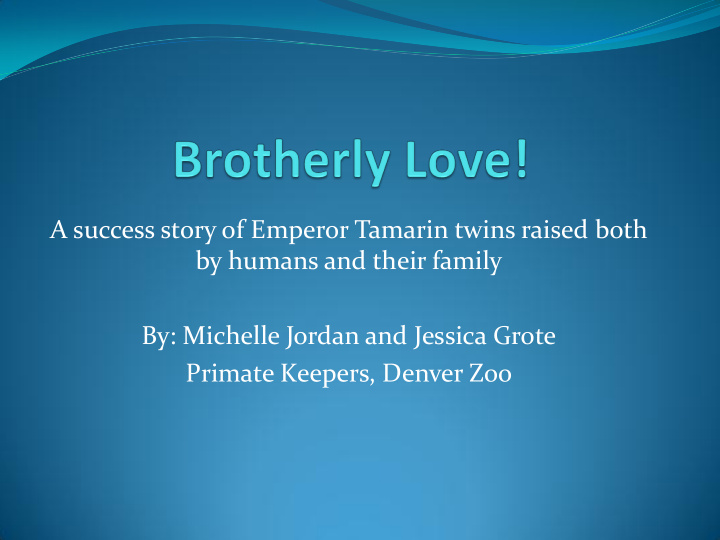



A success story of Emperor Tamarin twins raised both by humans and their family By: Michelle Jordan and Jessica Grote Primate Keepers, Denver Zoo
Natural History Emperor Tamarin Saguinus imperator Live: Neo-tropical Primates, South America Habitat: tropical rainforest canopy Diet: fruit, insects, small invertebrates, and plant matter Behavior: social, live in groups of 2-8 diurnal, territorial
Denver Zoo Emperor Tamarins Denver Zoo houses 1 male and 3 females
Birth of the twins Female Yana had several false pregnancies prior to July 2009 In July 2009, gave birth to twins Lara and Lucy Both mom and brother caring for twins successfully Brother was caring the twins more often Yana died unexpectedly three weeks after their birth Decision for Denver Zoo Veterinary and Keeper staff to hand-raise infants for some time
Emerald Forest Exhibit
Nursery 3 weeks of age • Private Room • Incubator and heat lamps • Staff wore smocks, masks, gloves • Natural hand-rearing Diet • Primilac Liquid Infant Primate Diet from BioServ • Warm Tap Water • Warm Pedialyte • Eventually, solid food pieces
Lara and Lucy’s Schedule age 3 weeks (July 2009-August 2009) two staff per feeding 1:30 am Weigh, measure temp and humidity of incubator, formula feeding, piddling, fuzzy time 4:30 am Weigh, measure temp and humidity of incubator, formula feeding, piddling, fuzzy time 7:30 am Weigh, measure temp and humidity of incubator, formula feeding, piddling, fuzzy time 10:30 am Weigh, measure temp and humidity of incubator, formula feeding, piddling, fuzzy time, sun 1:30 pm Weigh, measure temp and humidity of incubator, formula feeding, piddling, fuzzy time, sun 4:30 pm Weigh, measure temp and humidity of incubator, formula feeding, piddling, fuzzy time, sun 7:30 pm Weigh, measure temp and humidity of incubator, formula feeding, piddling, fuzzy time 10:30 pm Weigh, measure temp and humidity of incubator, formula feeding, piddling, fuzzy time
Rodeo Bouncy Motion after eating, prevents gut stasis.
Emerald Forest Incubator Visits age 4 weeks (August 2009) Feedings reduced from eight times a day to six times a day Infants strong, healthy and becoming more active Emerald Forest incubator from 8:00am-4:00pm Incubator located directly outside the cage where brother Paddy was living Resumed feeding schedule and infant care at Emerald Forest Paddy could see, hear, smell, and vocalize to them
Emerald Forest Overhead Ramp Age 5 weeks to 7 weeks (August-September 2009) Initially had half the ramp, then full ramp access Age 5 weeks still visiting during the day and returned to nursery at 4:00pm They lived in a small mesh cage in a quarantine room instead of in the incubator Age 6 weeks, the overnight feedings were dropped and they could live in the ramp full time Perching Baby toys Blankets, fleeces, stuffed fuzzy Ultraviolet bulb and heat lamp Solid food pieces
Emerald Forest holding cage Age 7 weeks-8 weeks (August 2009-September 2009) Overhead ramp and connected cage Initially set on fully bedded cage floor that had toys, blankets, perching, and rope
Emerald Forest Holding Cage • Feeding was done initially inside the cage, but soon fed through the mesh • Small shelf attached to front inside of cage • Increased weight and independence
Re-Introduced to brother Paddy September: 2 months of age Opened shift doors between Paddy’s holding cage and the ramp/cage where the girls were living They followed Paddy everywhere Continued weighing and syringe feeding on shelf Dropped syringe nipple and fed with syringes October: 3 months of age Introduced to more adult diet, enrichment and protein Shift from cage to cage in back holding November: 4 months of age Introduced to more adult diet, enrichment and protein Age 4 months dropped off of formula Target and crate training
On Display age 7 months (February 2010) Going out on exhibit Transfer through overhead ramp into two small holding cages just behind exhibit Once comfortable there, transferred onto exhibit Reside with one male elephant shrew Received birth control in June 2010 and first of the month every month after
Acknowledgements Denver Zoo Primate Department Denver Zoo Management: Primate Area Supervisor, Primate Area Curator, Curator of Behavioral Husbandry Denver Zoo Veterinary Staff Photographs: Denver Zoo Staff Dave Parsons, Jessica Grote, Cindy Bickel
Recommend
More recommend